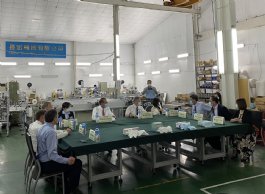WORLDWIDE

FAQ
Home > FAQ > F&Q
F&Q
Yes, because there are more and more mask styles on the market, each of the different styles of masks can only be manufactured on a single machine, except for some mask sizes that can be manufactured through mold replacement.
Our company has more than 20 years of experience in manufacturing mask machine equipment. Many customers who bought the mask machine equipment ten years ago still continue to use it and get maintenance services from our company, so there is no need to worry about the replacement of parts or parts due to the renewal of the mask machine. Don’t worry no one does service and other issues.
Yes, our company has another subsidiary that specializes in the production of ultrasonic equipment. It often serves customers to purchase ultrasonic systems from China or other brands to repair or change to our ultrasonic systems, so that future parts replacement is more convenient.
Yes, we have more than 20 years of experience in the field of non-woven machine design, so in addition to mask machine equipment, our company also designs various non-woven products machinery for different purposes, such as: shoe covers, surgical caps, nurse caps, 7- 11 Lunch bags, beverage bags, gift bags, facial masks, striped fabrics, dust bags, wet wipes, medical dust pads... etc.
For the hardware part, our company has specialized technical personnel and engineers who can do online troubleshooting. For the software part, our company has an electronic control professional team, only need to provide PLC signal lights to immediately know the problem, and immediately eliminate the problem.
Due to the global GOVID-19 epidemic has not yet eased, our company currently does not provide foreign diplomatic services, but our equipment is easy to operate, and hundreds of devices have been shipped abroad during the epidemic, and both the client and our company can handle it online Machine installation problem.
The new machine is guaranteed for one year, and the ultrasonic welding head is guaranteed for three months. Except for consumables, natural disasters and human factors, it is not covered by the warranty.
Please download document.
From the tweeting of birds to glass-shattering screams – sound is more than just what we can hear with our ears. It's created by the mechanical vibration of bodies. This doesn't just happen in the air, but in every elastic medium, i.e. gases, liquids, and solids.
Ultrasonics are an example of the fact that humans cannot hear every type of sound. High-frequency sound waves are used in industry and medicine, and these cannot be heard.
Sound waves are categorized by their frequency (number of waves per second). For example, ultrasonics range from 20 kHz to 1 GHz. Ultrasonic welding uses frequencies from 20 kHz to 70 kHz. The lowest range of this can still just be heard by human ears. This is because audible sound (for humans at least) has a range of only from 16 Hz to 20 kHz. At most, oscillations going above this are perceived as vibrations.
Ultrasonics are an example of the fact that humans cannot hear every type of sound. High-frequency sound waves are used in industry and medicine, and these cannot be heard.
Sound waves are categorized by their frequency (number of waves per second). For example, ultrasonics range from 20 kHz to 1 GHz. Ultrasonic welding uses frequencies from 20 kHz to 70 kHz. The lowest range of this can still just be heard by human ears. This is because audible sound (for humans at least) has a range of only from 16 Hz to 20 kHz. At most, oscillations going above this are perceived as vibrations.
When the ultrasonic vibrations hit a material (e.g. a plastic), the molecular chains start to oscillate. The molecules start to move and rub against each other. This generates energy (referred to as friction heat). In the case of thermoplastic materials, this process causes them to start to melt. Ultrasonic welding takes advantage of this principle. After a short hold time under additional pressure, various materials (components) can be welded together at a molecular level in the joining area.
Ultrasonic welding happens in split seconds without the need for any aids such as adhesives or screws. Ultrasonics are used to create packaging, car parts, toys and much more, for example, by:
*Joining injection-molded parts (e.g. for toys)
*Embedding membranes (e.g. for filter membranes in medical components)
*Fusing leather, nonwovens and textiles (e.g. air filters in cars)
*Staking different types of materials together (e.g. for airbags)
*Creating form-fit joints using a shaping technique (e.g. for magnet contacts in chargers)
*Countersinking sockets and magnets (e.g. encapsulated magnets for activating sensors)
*Joining injection-molded parts (e.g. for toys)
*Embedding membranes (e.g. for filter membranes in medical components)
*Fusing leather, nonwovens and textiles (e.g. air filters in cars)
*Staking different types of materials together (e.g. for airbags)
*Creating form-fit joints using a shaping technique (e.g. for magnet contacts in chargers)
*Countersinking sockets and magnets (e.g. encapsulated magnets for activating sensors)
The complete ultrasonic welding system consists of various components. The active components generate the vibrations, transfer them, and apply them into the weld joints. The passive components absorb the resulting forces, hold the parts in position, and particularly support the weld joint point at which the components are joined together.
Active:
Ultrasonic generator
Converter
Amplitude transformer (booster or amplitude coupler)
Welding block (HORN)
The converter, booster, and sonotrode are combined to form what is referred to as the stack.
Active:
Ultrasonic generator
Converter
Amplitude transformer (booster or amplitude coupler)
Welding block (HORN)
The converter, booster, and sonotrode are combined to form what is referred to as the stack.


